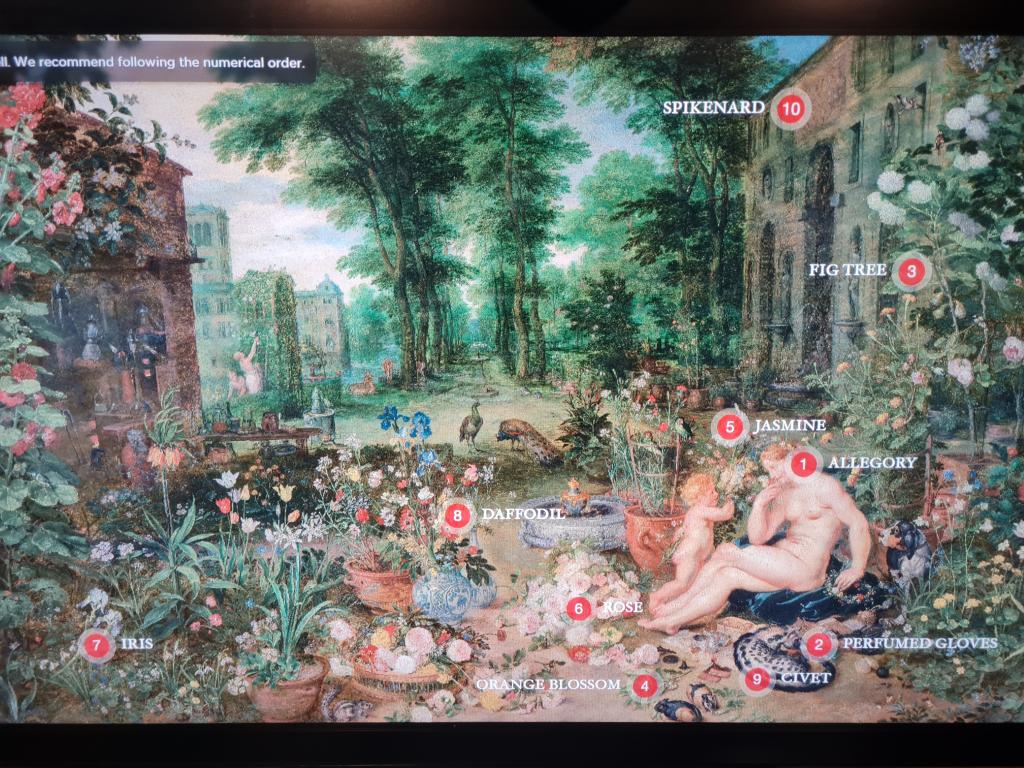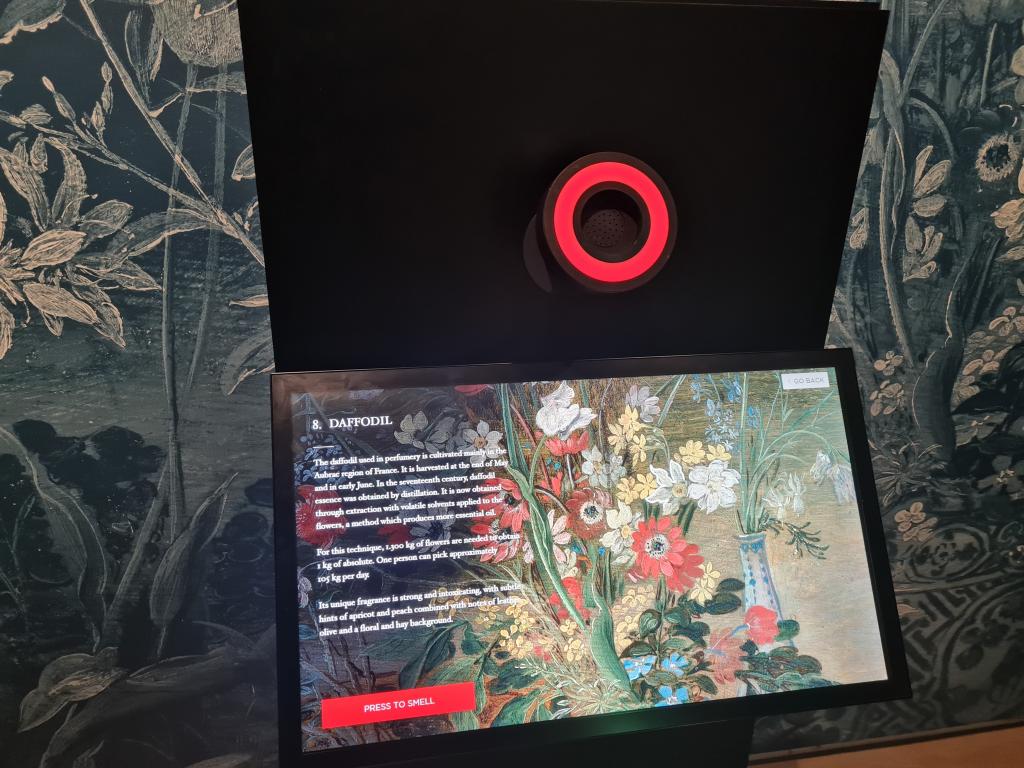The new Prado exhibition smells just as sweet as it appears.
In Shakespeare’s words, Juliet Capulet famously asks, ‘What’s in a name? That which we call a rose by any other name would smell just as sweet.’
The line from Romeo and Juliet reverberates when you visit the Prado Museum’s sensorial celebration of Jan Brueghel and Rubens’ painting The Sense of Smell, which, thanks to a collaboration with Samsung and Puig, you can now lean in to sniff. If the smell of rose soothes, or sweetens you to feel romantic on a day out in Madrid, you’re in luck here.
Coming two summers after Coronavirus caused galleries to undergo a major rethink, the Prado’s The essence of a painting: an olfactory exhibition, is a pleasant surprise. It uses touchscreen monitors and air diffusers to sharpen the sense that for many of us was dulled by Covid-19.
The showcase, The Sense of Smell, is one in a series of five early 17th-century paintings thought to have been commissioned by Isabel Clara Eugenia and Archduke Albert of Austria, who ruled over the Spanish Netherlands.
It’s not the history of the painting that impresses, however, or at first glance the technical craft of Brueghel and Rubens’ brushstrokes, but the marvellous daydream we’re gifted, for our eyes and for our nostrils. In a dimly lit gallery, you’re transported to the Brussels court of King Philip III’s sister, infanta Isabel Clara Eugenia. If this sounds inanimate and grey, think again.
Brueghel’s reimagined setting evokes Spring days sitting down for a picnic by a stream. Wildflowers and valuable trees abound. Better still, when you take advantage of the Air Parfum technology, developed by perfumer Puig, The Sense of Smell is a cascade of some of your favourite fragrances. Depending on what hour of the day you visit, you can have one of the four air diffusers to yourself. The screens guide you as you associate the smells with the objects in the painting. From there you learn more about how each object was treasured by early modern Europe’s elites.

Besides rose, there are nine other scents to behold in this experimental exhibition, most of which are equally aromatic. Some of the smells are familiar, such as jasmine and daffodil. Others transport us to long-forgotten memories. The perfume created to represent the allegorical figure of smell in the painting, a cherubic figure clasping a bouquet, took me back to Saturday evenings as a young boy. My mother would come to kiss me on my cheek as she headed out, liberally perfumed. The gallery advises us that the ingredients that Puig’s senior perfumer, Gregorio Sola, has drawn on for this particular fragrance include the carnation and much earthier notes, but I revelled in revisiting a smell I hadn’t thought of for years.
Sola, one of two curators along with the Prado’s Alejandro Vergara, has been quoted saying our ‘olfactory memory’ is stronger than our visual or auditory memory: we all have our own individual memories of smell and the associations we relate them to. If it’s our ‘olfactory memory’ that needs reawakening, the smell of perfumed gloves might uncloak some of our fondest memories. Elsewhere, the humid whiff of the Fig Tree conjured up memories of drying clothes dancing on a clothesline in a summer breeze.
No animals were tested or used in the manufacturing process, but one of the smells, Iris, is obtained not from the flower but from its root (called orris root) which the curators state ‘must mature between five and seven years before it can be pulverised into orris butter and distilled.’ Apparently, iris root is one of the priciest ingredients in perfumery – its value is twice that of gold.

Less expense is incurred, one imagines, in concocting the smell of the musky civet, which recalls excrement. The fluid which civets secrete from between their hind legs contains ingredients with stabilising properties, which in the 17th century, perfumers would use to bind together with other scents. It’s the one smell of the ten that had visitors to the exhibition recoiling, instead of leaning into it.
The exhibition finishes on a more enjoyable note as you’re invited to inhale and drink in spikenard, a costly ointment depicted in the biblical episode of the anointing at Bethany. There weren’t floral notes, not obviously, but instead, one could smell old liqueurs, and if you’re really imaginative, you might visualise after-dinner drinks in an old library where the liqueur gets served.
Along with the arabesque notes of orange blossom, which wouldn’t be out of place in the Alhambra, there’s a palette of colours and odours to feast on in the Prado this summer. The four other paintings in Brueghel and Rubens’ 1617-1618 series on the senses, all of which arrived in Madrid to decorate King Philip IV’s gold and ebony shelves, aren’t quite as stirring as The Sense of Smell. It’s this oil painting you’ll cherish and return to in Gallery 83.
A word of caution. Not that you would, but don’t visit if you have a cold. There are smells you’ll want to treasure, so plan to visit this exhibition for around thirty minutes, and let them linger.
The exhibition runs until 3 July 2022 and is open from Monday to Saturday, from 10 am to 8 pm and on Sundays and holidays, from 10 am to 7 pm. The entrance ticket costs up to €15 but can be €7 if you can purchase a concessionary ticket. The main collection can be accessed for free later in the evenings. Tickets can be booked online, which is advised, and recommended times for viewing the exhibition are during lunchtime. Click here for all further information.
Andrew Kaye Kauffmann is a freelance writer, teacher and coach. He offers coaching sessions for individuals looking for change in their professional or personal lives. He blogs at www.andrewkauffmann.co.uk
If you’d like to contribute to ‘Spain in English’ please email us: editorial@spainenglish.com. We’d love to hear from you.

Sign up for the FREE Weekly Newsletter from Spain in English.
Please support Spain in English with a donation.
Click here to get your business activity or services listed on our DIRECTORY.


